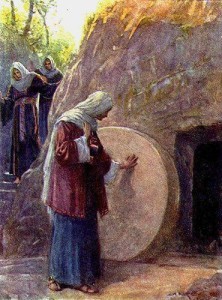Tags
Beyond the Cosmos, Christ, Christianity, Dr. Hugh Ross Ph.D, Everlasting, Experience, Family, Freedom, Genealogy, God, Jesus Christ, Lessons, Liberty, Life, Posterity, Teaching, The Passion of the Christ, Wisdom
Share it
In one part of his opening chapter of Beyond The Cosmos (linked at the end of this post) the author Dr. Hugh Ross, Ph.D., enlightens we the readers with this insight: If we are anything like the people portrayed in the Bible, we wish “God with us” were much more tangible. Which of us does not sometimes question, as the first disciples did, why it is better for us if Christ (our physical proof of God’s reality, power, and love) returns to heaven and sends the invisible Comforter, Counselor, Holy Spirit in His stead? Since Jesus said it, we accept it. Nonetheless, we wrestle with it. If only we could get a better grip on HOW it is better!
In this Passover/Easter weekend, traditionally the time when thousands and thousands of unbelievers finally get a dose of the Holy Spirit and begin to believe the unbelievable, I “gift” you with this piece, the text of which I’ve excerpted out of Dr. Ross’ outstanding treatise, and added a touch or two of my own “God with us” experience and insights, to which I pray the Holy Spirit will add His imperious touch, and open the eyes and hearts of all of us, on this most Holy of weekends…. Soli Deo Gloria!
Simultaneous Death and Life?
When Jesus of Nazareth died on the cross, much more happened than a physical death. The book of Romans reminds us that sin entered the world through one human’s decision to disregard God’s way and to act on his own authority. This first expression of sin did not cause Adam and Eve to immediately drop dead physically. Physical death came to them some time later. Neither did they lose their capacity to hear God’s voice. But sin’s consequences were indeed profound. Humanity tasted autonomy, a separation of self from the Source of all life, goodness, truth, and love. The branch disconnected itself from the vine and sought sustenance elsewhere. The evils, pains, and sufferings that followed in Adam and Eve’s lives and in the lives of all their progeny demonstrate the devastating results of that initial separation.
Adam and Eve were not the first creatures ever to taste autonomy. But they were the first human beings to taste it, and in doing so they placed themselves, their family, and all their descendants in the camp of God’s enemy, the instigator of all insubordination and evil: Satan. Who could repair such damage? Adam was helpless to do so, however remorseful he may have been. No human after him could accomplish the repair, for each was born of that separated branch. The angels, however magnificent and obedient, lacked the capacity to carry it out. Only God Himself could make the mend.
In one moment – for Him, what could be an eternal moment because of His extra dimensions of Time – Christ crossed the divide caused by sin. The Bible says, “God made him who had no sin to be sin for us,” taking into Himself the wound of separation, the enmity or wrath of God against sin. In a human body, He proved His perfect obedience, His wisdom, and His power to live – and die – with the capacity for autonomy and yet wholly (“holy”) attuned to the Father’s will. He lived up to God’s perfection and qualified Himself to pay the ransom price, namely His own death, for the penalty incurred by humanity’s sin. His death in the physical dimensions of time and space was real, not feigned, an experience He chose to undergo on our behalf. But He also experienced the indescribable spiritual torment of hell, of being shut out in some way we cannot picture, from His Father’s approbation.
Both God and Man
We human beings have no control over the four dimensions we experience; we can neither gain a dimension nor lose one. But God’s control and mastery is complete. He created our four dimensions (ie length, breadth, height, and depth) and several more. Obviously, if God can create and enter dimensions, He can remove and leave them. With such capacities, He has free reign in choosing which ones He will use to interact with us. Further, He can choose to be bound to, or use one set of, dimensions for certain contexts, while choosing other sets of dimensions for other contexts.
Examples of Jesus’ control over dimensionality while He was with us in human form may be found throughout the four gospels. One appears in the account of the temptation by Satan. Jesus, near death from starvation, was reminded of His supernatural capabilities. All Jesus had to do, Satan goaded, was to turn the stones scattered about Him into bread. Such a proposal would pose no temptation for any of us for the simple reason that we would be unable to act on it. The temptation might sharpen our hunger pangs when we heard mention of bread. It might tempt us to hurl some of those stones at our tempter. But to transform the stones into food would be impossible for us. Satan’s approach in this temptation suggests that though Jesus had imposed on Himself the limitations common to humanity, He retained the capacity to deliver Himself from those limitations at any time and any place He chose.
A more explicit demonstration may be seen in the story of the stormy sea of Galilee crossing. While Jesus slept in the stern of the boat, a squall came up, threatening to capsize the vessel. Fearing for their lives, the disciples awakened Jesus. When He saw the men’s panic, Jesus at once rebuked the wind and told the waves, “Be still!” Immediately, the wind died down and the surface of the water became completely calm. The incident shows the capacity of Jesus to transition between contexts. First we see Jesus submitting to the wind and waves He created. In the next moment, however, Jesus exercises control and authority, as God the Father’s agent, over the elements. In the first context, we see Jesus’ humanity. In the second, we see His divinity. Jesus can be both God and man because He alone can choose when and where and with what part of His being and essence to operate in whatever form and over whatever dimensions He pleases.
Beyond Our Imagining
The Incarnation is described in the second chapter of Philippians as Christ’s becoming “nothing.” Such a statement does not deny the wonder and worth of human beings, but it does express the magnitude of Christ’s divestiture in accepting life as a human. The humility He demonstrated in coming to us and dying for us exemplifies the humility we need in coming to Him. His example of humility, rather than hinting at any weakness or inferiority, indicates just the opposite – the moral perfection of God alone.
The differences made by the dimensional gap between our existing four dimensions, and the seven-or-more dimensions between us and God makes the statement “becoming nothing” even more significant to the degree of what Christ gave up to become one of us in order to save us. What is more, the Incarnation and the Atonement show us God’s capacity to operate in any dimensional realm, any combination of space and time dimensions (or super dimensions) He chooses. He can also manifest different aspects of Himself in different dimensional realms. The reality in which He can live and move supersedes by far the limits of human imagination. And yet we know He wants us to try to imagine it, to anticipate our future in it, because He gave us sneak previews – in His Word, in His creation, in His Incarnation, and in His Atonement.
When the disciples were visited by the resurrected Christ, they were able to see and feel the wounds of His crucifixion. Christ certainly had the power to eradicate these wounds, but He chose to let them remain. One reason may be that these marks were essential to convince the disciples of the reality of Jesus’ bodily resurrection. The wounds identified Him as nothing else could have. And no doubt these marks helped him remind the disciples of what the Creator willingly endured to atone for their sins and of the permanent effects of that atoning sacrifice. This kind of reminder may be of some benefit to future generations of disciples and even to the hosts of angels and demons.
Whether these marks of the cross will remain for us to see when we enter Christ’s presence we do not know. The book of Revelation, which gives more description of the heavenly realm and of our future than does any other portion of Scripture, gives no clear answer to this question. Yet we can speculate that when the magnificence of the new creation is revealed to us, and when we begin to fathom the loss and the horror that hell represents, we may well be sufficiently reminded of the magnitude of the price Christ paid for our atonement.
Even so, come, Lord Jesus. Amen. Maranatha. In HIM!!
Text excerpted from Beyond The Cosmos Chapter Ten, by Dr. Hugh Ross…
Soli Deo Gloria!





 Link To DennisGHurst.com
Link To DennisGHurst.com


